- Let me begin with a question about your background. How did you start to get involved in the arts?
-
I am not a specialist – my background is as an industrialist. I run a factory producing textile chemicals. However, since my childhood, I have been interested in the arts – music, pictures and photographs, including our traditional arts and culture. And actually, I have been involved in the arts for 30 years – I have designed costumes for opera, directed shows and curated exhibitions. The arts have always been a passion more than a job for me.
My non-specialist background sometimes helps me to set up a project. For example, a project titled Intriguing Instruments , which will be premiered in this year’s George Town Festival, started from my simple admiration for the music. When you look at the instruments, you will wonder, “How does the sound come from this thing?” Some instruments look very weird. How can such a beautiful sound be generated in this wooden box? The show invites unique instruments from all over Asia for street performances. Audience members will understand the sound, touch the instruments and feel them. - I learned that you studied in the UK. How did it affect you?
- I went to England at the age of 18, and was not so passionate, maybe latent. When I was in England, I was always being exposed to Western culture. Through this exposure, I think I grew to love our own culture. When I came back to Penang, it switched on my passion for the arts. I am not saying that we should reject Western culture. We can learn a lot from it – the technique of how to appreciate the different kinds of arts, for example.
- George Town Festival was inaugurated in 2010. How did it get started? How did you get involved in?
-
Penang was listed as a UNESCO World Heritage site in 2008 and the State Government wished to have an event to celebrate it. I was asked to help. They gave me six days – yes, just six days to plan a show. I created a show called
Musical Tribute to Penang
, which was a collection of Penang music – from the old musical theatre to the current pop music. Within six days, I got one hundred people on stage. That was the first show. The second year, I was given 14 days to do another show. These shows were one-day events.
But in the third year, it was decided to make it a festival. There were three proposals from local groups – Arts Alliance, Penang Heritage Trust and Chinese clans. However, eventually none of them wished to take the responsibility to hold the festival. Thus the state asked me whether I could help. I was given six weeks to plan the first George Town Festival in 2010. I called people I know from all over the world to say, “Hey, can you help me do this?” The people who agreed to join the festival included Singaporean filmmaker Glen Goei, Malaysian film director Saw Teong Hin, Japanese soprano Ranko Kurano, and artist Leon Lim from New York.
For the second festival in 2011, we had four months to plan. Last year, we had five months. I have to admit that it is still a luxury to have five months in the Malaysian environment. It is a problem that nobody understands we need a few years to plan the festival properly. - The festival has been growing, and it has been recognized as one of the most vibrant arts festivals in the region.
-
The first two years was a period of learning for me – learning how to brand the festival and to make it known locally and regionally. In that sense, we were very lucky to be able to bring in the works of internationally acclaimed artists like
Vertical Road
by choreographer Akram Khan in 2011 and
The Manganiyar Seduction
by Roysten Abel in 2012. For the 2013 festival, we have received 150 proposals from all over the world, as far away as Brazil, Portugal, Canada, the UK and Australia.
The last three years, I have really enjoyed organizing the festival. It’s been difficult, but I have never been happier. I found this is my reason to live. And, I am blessed to share it with other people. So many people came to help me. I just wrote to Akram Khan, called him, and he said, “Yes.” And he is booked for 2 years. In the case of The Manganiyar Seduction , it was funny. How can it be that a festival director contacts the artist through Facebook? But, that is what I did! When I met Roysten in person later, he said, “This is something, really a treasure. I never looked at Facebook. One day I happened to see it, and I responded to you.” I was really worried because we did not get enough funding last year. But he said, “Don’t worry, Joe. It takes seven years for a festival to really make a name. In two years, sponsors will queue up in front of your office if you continue what you are doing now.” So many people gave me these kind words. I am really blessed. This has been a terrific journey. - The expansion in terms of the scale of the festival is, of course, very significant. However, what is even more impressive for me is the programming. How do you program the festival? What is your policy of the programming?
-
I have total freedom in the programming. We have no committee. We have no guidelines. I make the decisions myself based on my own sense, which I know is very unusual. I am very privileged and grateful to have an understanding Chief Minister of the state, who set this kind of environment. Of course, I know my responsibility is enormous. I personally lost 300,000 Malaysian Ringgit (US$98,000) last year. It was not publicized and not known to many people. But I still think being a director of the festival is a blessing. How many festival directors can be given a blank canvas? Even the most generous agencies would tell you, “You can’t do this, you can’t do that.” But, no, the state government does not restrict me in that way.
This is connected to my second point. I myself have to secure the creative freedom in the festival. This is particularly important in Malaysia, where the affirmative policy for the Malays is at work. Malay culture is always privileged and considered almost untouchable. However, for example, I staged a concert of sacred music in a (Christian) church. Penang is a special place that allows this kind of artistic experiments. If I do the same thing in other states in Malaysia, I am sure that a fatwa (juristic ruling concerning Islamic law issued by Islamic scholars) will be directed at me! I can do the programming with no bias to any specific race, culture or religion in this festival. We simply do what is good and genuine. - The festival has a good balance between the performances by the internationally acclaimed artists like Akram Khan on the one hand, and the local and community-based projects.
-
Yes, I think the balance is important in two ways. First, is the balance between the programs to educate the local people and those to inspire them. It was the reason why I brought
The Manganiyar Seduction
last year. I knew it is very hard to excite the new audience regarding traditional music. Roysten did a brilliant job, putting musicians of traditional Rajasthani music in small pigeonholes, making it visually stunning and, at the same time, enjoyable and accessible for the public. It is not about the bigness of the name of the artists, but about inspiring local people.
Second, there should be a balance between what the local people wish to have and what the foreign visitors want. I started a project with local videographers to interview people – local people from every layer of the society and foreign visitors, asking two questions: One, “What do you think of George Town Festival?” and two, “What do you want from the festival?” It is, for me, about learning. I may not be able to change the festival this year, but at least I understand what the people want. Then I can find a good balance to make the festival attractive to the visitors and, at the same time, to make the local people feel the festival belongs to them. - It seems that the city of George Town is always in the centre of the festival. One of the most talked-about projects in the 2012 festival, Mirrors George Town by Malaysia-based Earnest Zacharevic, is a street art project that consists of wall paintings combined with real objects like a chair, a bicycle and a motorcycle in the heart of the heritage zone of the city. I walked around the area yesterday and found these artworks have been well integrated into the townscape.
-
I believe that the festival has to be relevant to the local communities, and it has to be current. “What is happening in your society?” is an important question to ask. Some of my key focuses are the public, community and spaces.
Mirrors George Town
is a project with these focuses, and it became the biggest thing in last year’s festival. When the artist came here and did murals for the first time, nobody paid any attention. But I saw the drawings, and felt, “Wow, this is interesting.” Because the project has become well known by now, so many artists start to propose similar projects to me. But I keep saying “No” to them. I don’t want to turn every wall in Penang into graffiti or drawings.
Instead, this year I have a project called Secret Gardens of Earthly Delights . This project is inspired by a surreal painting titled The Garden of Earthly Delights by Hieronymus Bosch. I have explored the roads, spaces and walls in George Town suitable for this project. We will turn them into 10 “gardens.” I will get installation artists, landscape gardeners and mosaic artists and let them use the space in these “gardens” – it could be a wall, a space between two walls or a floor. People will walk into the gardens and suddenly stumble into the art works and think, “Oh, what is there?” It’s arts, gardens and people in one. It is important that the local community takes an ownership in this project. Because I do this next to your house, it is yours!
Just importing something and showing it does not mean a lot for me. If you do that, your festival looks like the other festivals. Whereas if you bring it to the grassroots level, you will have what is special with your people, space, community and culture, then you will have something interesting. This is what I am trying to build. If you do so, the people will start to feel it is their festival. Otherwise people will consider it the government’s festival, which is a phenomenon many festivals without interactive programs are beginning to suffer from. So, my big words for this year’s festival are; “Community, Interaction and Spaces.” “Localisation” is an interesting word. Again, we need a good balance between the globalization and the local uniqueness. - How do you get the local people involved in the process?
-
I take photographs, I do research, I meet the household people and I ask them. It is about getting them to feel this is their festival. They own it. It’s yours.
For Mirrors George Town , we located the owners of the buildings whose walls we wish to put paintings on, we talked with them as well as the town council – that’s how it went. I have started groundwork for Secret Gardens of Earthly Delights . We have taken photographs of 10 locations I want for the “gardens,” and approached the owners. Once they agree, we will send the photographs to the artists to let them come up with the proposals. - You mentioned that you receive proposals from the artists. You also commission some artists to create new works. This means you have two ways to get your programs, doesn’t it?
-
Yes. We put up the notices saying we are looking for proposals. As our festival has come to be known by the artists, we start to get quite a number of proposals. I also travel abroad, usually twice or three times a year, to find good performances, although I did not have much time to do so the last two years.
At the same time, we help small local groups to stage their productions, and commission bigger groups to create their works. For example, we commissioned a production called Silat , a hybrid of the choreographed martial arts performance infused with traditional music and contemporary visuals. This year, we are commissioning the Indian dance company Temple of Fine Arts to do Ramayana , in which we hope to link all of their branches in the region.
We understand our job is to make the festival a platform for the creative talents. We meet people who come up with ideas, and see whether we can help them either in terms of finding or nurturing the project. I don’t want shows of seronok sendiri (delight only yourself).
Commissioning works that suit your festival is very important to develop the identity of the festival. For example, I am trying to get Rimini Protokoll’s 100% for the 2015 festival. It was about the population in a specific community – it connected statistical facts to the life stories of the local people. It is truly brilliant and I immediately thought of the possibility to bring the show to Penang, and commission to create a Penang version of 100% . This is a story about the people and about “you.” To me, this is an important type of the show. - Silat seems to be a significantly “made in Penang” production. It was directed by Penang-born Saw Teong Hin and choreographed by Penang-based Aida Redza. How was the project planned? Is ‘made-in-Penang’ critical for you?
-
Silat
was Saw Teong Hin’s idea and I initiated the process. It is based on a Malay traditional martial art and it was a marvelous learning experience concerning its ritual. My only regret is that we did not have a chance to go deep enough. This is why I call it a work-in-progress. I think I have a Buddhist outlook in my head – I do it, experience it, and learn from it. Let’s put it this way. Do your best. Maybe your perfection cannot come in this production. But it is important to enjoy the moment, give it all, but not to hold on to it.
I am working with Aida Redza in another production for this year’s festival called Kaki Lima . It is a school production about anak-anak kota Pinang (children of Penang). I wish to nurture our own talent through these “made in Penang” projects. Every year, we try to have one or two projects specially commissioned or assisted by the festival. - It is interesting that some of the works were quite site-specific. 2011’s commission, No. 7 written and directed by Keylene Tan of Singapore’s Spell#7 was staged in the Blue Mansion, which won UNESCO’s Heritage Conservation Award.
-
I met [the leading actress of
No. 7
] Tan Kheng Hua during the first George Town Festival. No. 7 is about the seventh wife of Chinese tycoon Cheong Fatt Tze, who was based in George Town in the late 19th century. It was a story that I always wanted, which is about the history of George Town.
The venue of the performance, Blue Mansion is the restored residence of Chong Fatt Tze, which is now used as a hotel. We had no problem to use it as a venue for the performance, but the only restriction was the size of the audience. Because of the limited space of the mansion’s yard, only a small number of people could watch the performance.
We can use these historic buildings for performances because we are in Penang. I feel so special being in Penang. The State and the people are willing to help. I get the Town Hall for one month for free. I get the roads closed purposely for the festival. This is the spirit of George Town, which you cannot find, for example, in Kuala Lumpur. The sense of ownership is so strong among the people of Penang. They own Penang, they own George Town. This is because we are very small. It is like a small village. - Now let me ask about film, which is seemingly an important part of the festival. Especially, Tropfest, the largest short film festival initiated in Australia, has been integrated in the George Town Festival.
-
I went to the house of the Australian High Commissioner three years ago and was informed about the Tropfest. This Australian festival was interesting, funny, entertaining and enjoyable. I saw 15 films that had participated in the festival, and I liked them all. So I met the Managing Director of the Tropfest, Michael Laverty. When I met him, I found we shared the same passion about people – young people. Thus I proposed to him a Southeast Asian version of Tropfest hosted by George Town Festival. ASEAN was set up some 40 years ago, but its focus has been only on economy. Nothing has gone beyond boundaries culturally. I wished to see ASEAN as a cultural platform through this project. Michael agreed, but he suggested I had to talk with New York-based Australian actor and director John Polson who is a founder and director of the Tropfest. A few months later, we set up a telephone meeting. He liked what we did in George Town Festival, and invited me to New York to discuss things further. Thus, I flew to the United States, signed a contract, and now we have rights for Southeast Asia.
Australians are so successful in the United States in the last 10 years, and they help each other in Hollywood. The winner of the Tropfest gets to go to Los Angeles, paid by the Motion Picture Association. Thus, I thought they could help us too. The other side of the coin is that there are so many rich Southeast Asians who might want to be producers of the art movies of Australia. It would be possible to develop our relationship in a mutually beneficial way. So, it is also about finding ways to collaborate on the business side. Although I have been involved in the arts for so many years, I still have a business mind. - Is such a business mind at work in the George Town Festival itself?
-
For sure, there is the business side of the festival. I could not put on any of large-scale local shows, because nobody would fly in to watch these shows. Creative people think the society should support them. Yes. It is corporate social responsibility to support the arts. But it is not necessarily their duty. You cannot expect corporate sponsorship as the main funding source for the arts. If you do, you will die. “How do you find a way to sustain things?” This is a question I always keep in my mind.
Merchandising, self-funding, business science of the arts – these are the things that excite me. If I can develop a model, other people will be able to use the same model. For example, right now, we are planning the “Festival Card.” For 50 Ringgit you buy this card, and you will get an airline voucher worth 100 Ringgit and 50% off of on tickets for the shows during the festival. This is my way of finding my own funding. I hope to launch it this year.
I do not want somebody to sponsor me to just get a name. We have to be able to find reasons for people to give us money, in other words, what you can give them back. I am approaching Air Asia, a fast-growing local budget airline, saying, “Look. Currently I have 5 million hits on my website. Last year, we had only 1 million. Next year I want 20 million. If that many people view our website and decide to fly to Penang, you will benefit from that.” It has to be mutually beneficial – you support us, and we support your industry. We can build similar relationships with hotels and developers. I usually tell them, “Why would the people buy a 5-million dollar house in Penang if nothing is happening outside the door?” If they have a reason, it will make our relationship a strong partnership, which is not only a sponsorship. So, it is a symbiotic relationship – all of us are sailing in the same boat in the same direction. We need to build a cultural capacity with local audience, sponsors, and artists.
I had to make a good plan to sustain the festival. The first three years were for just anchoring the festival by building the name of the festival. The next three years will be about self-sustaining, building a bigger network and getting stronger partners. I am not saying we don’t need public funding, though. We cannot survive without it. And, I believe it is a duty of the state to nurture the arts, and it should always be a sponsor. However, I think the proportion should become less and less. Although the state needs to remain a backbone of the festival, it should not own it. I think that is wrong. - Among the 2011 Festival programs, there was a Japanese Bon Odori dance festival. How was it organized? Did you have any Japanese collaborators?
-
No, it was solely organized by the local tourism ministry. It was a very popular event and lots of people came. It was a fabulous festival. But, for me, it had gone in the wrong direction. It was just an icing on the cake. There was no seriousness. No second layer of education – educating people, explaining what the culture is. We should raise the bar. Why can’t we include serious exhibitions about Japan, Japanese history and Japanese people in Penang? There is a very interesting history of Japanese in Penang. And I know there are people who know a lot about it. We could integrate them into our programs. Then the event would have many layers, for which people thought it was worth coming to Penang and spending a whole weekend.
One of the projects I am working on for this year’s festival, which is about the diaspora of Malays, can be a model. Malaysians think they own the word “Malay,” but it is not true. We have Malays in Sri Lanka, Cambodia, and many other places. I will call scholars to discuss who the Malays are. Research papers will be presented in the workshops, and at night, we will have a gala concert using traditional instruments from different Malay communities all over Asia. We will see how these threads are woven into one program.
We have not received any proposals from Japan for this year’s festival so far. It is a bit of a shame because I always appreciate the fact that foreign embassies and agencies, including Japan Foundation in Kuala Lumpur, have been supportive of the non-mainstream culture in Malaysia. They have provided a platform for Malaysian experimental artists who otherwise cannot survive. They support arts purely for arts’ sake – without considering direct benefits.
This February, I am invited to Japan to attend Tokyo Performing Arts Market. I hope to make it an opportunity to get connected to my Japanese counterparts. I want to build a serious collaborative relationship with them. - I wish to conclude the interview by asking the general situation of arts in Penang. The capital city of Malaysia, Kuala Lumpur has long been a centre of the contemporary arts in Malaysia. However, Penang seems to be quickly establishing itself as a city of culture and arts. How do you see the arts scene in Penang? The new State Government of Penang led by the opposition party seems very supportive of the arts.
-
There is a momentum in Penang. It is basically a renaissance. The UNESCO World Heritage listing in 2008 helped it, but it is not just that. I think the time has come back for us to flourish again. I feel the energy of the earth. People are excited about Penang again. Everything is starting to work in favor of this place, including the new government.
This government is new, thus with less experience. Frankly speaking, they do not have a clear vision or roadmaps to develop the arts and culture in the state. I even asked the Chief Minister himself, “Why are you having a festival? What do you want to achieve with this festival?” I have my own answers. But the state also must have an answer, mustn’t it?
This is not a problem only in Penang but also in Malaysia itself. As a country, there is no strategy for the arts. They plan festivals without any long-term visions. Let’s look at, for example, Kuala Lumpur International Festival, which is nine years old now. It is no more than a series of events, solely for the Malay audience. They are repeating the same programs every year without any long-term vision. When I had a press conference on my festival in Kuala Lumpur, I asked the journalists about their opinions on this festival. Some of them didn’t even know the existence of the festival! We have to grow after 9 years, don’t we?
However, I admire our Chief Minister because he gave me total freedom as I mentioned earlier. He has courage to try. When he extended my contract until 2015, I said to him, “I will do this only if you are here. The minute you leave, I cannot continue.” It is very difficult to work with the people or institutes that do not respond quickly. The Chief Minister does. I have never got support like that from anyone or any agencies. - How about the cultural facilities? In 2011, the Penang Performing Arts Centre (Penang PAC) opened and many of the 2012 Festival events happened there.
-
Yes, Penang PAC is an important addition. However, we are still short of venues, although we have another main venue called Dewan Seri Penang. This is a handicap of the George Town Festival, but it is at the same time a plus point because I had to look for other non-traditional performing venues. The idea to bring shows to the streets came to me because of that.
In 2010, a Japanese soprano Ranko Kurano sung opera arias on the streets, which was, for me, probably the most magical event in the last three years. 400 people gather, sat down on the benches and stools and listened to her singing. The audiences were not only opera lovers. All kinds of people – aunties from the shops, trishaw men… these people came and enjoyed the music.
A lot of people are afraid of classical music. You feel you are not that clever, and not qualified to enter the music halls filled with rich, well-dressed people. I kept thinking about how to approach the contemporary audience, going over the existing circle of audience. That event was an answer to this. - Being established as a vibrant festival, the George Town Festival has to, in a sense, compete with other regional festivals. How do you see the future direction?
-
I have visited some other festivals to learn how they worked, and if they did not work, what was wrong. We are small, and there are so many cities hosting large arts festivals in this region like Singapore, Melbourne, Adelaide, Macau, Taipei and Hong Kong. How can we ever compete with them? We do not have large halls. We do not have a lot of funding.
But we have a story. Penang, George Town has a story. Every corner of the city is a gallery. Every wall is a gallery. The festival started with this as a basis. We cannot directly compete with other festivals. Thus, we needed to find our own identity. And our identity is George Town. Although I balance the international acts with other elements, the core of the festival has always been about George Town – sharing George Town with everyone else.
Joe Sidek
Born in a World Heritage town,
the George Town Festival
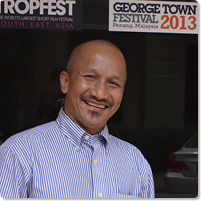
Joe Sidek
Director of George Town Festival
In 2008, George Town on the island of Penang in Malaysia was added to the UNESCO World Heritage list. In the British colonial period the island of Penang was called Prince of Wales Island and served as a trade base for the British East Indies Company and today it is one of Malaysia’s prime tourist destinations. The central George Town district still retains much of the colonial period architecture and its diverse population of roughly 400,000 has many ethnic Chinese, Malays and Indians. In this World Heritage town the George Town Festival was launched in 2010. Since then the festival has welcomed such internationally renowned artists as Akram Khan in 2011 and Roysten Abel in 2012 and has tied up with international programs like Tropfest, the largest short film festival that began in Australia. Another mainstay of the festival is the “Street Art Project” making use of venues on the streets and scenic places around George Town and productions based on the traditional Malay martial art of Silat and other arts and culture indigenous to the island of Penang that the festival actively promotes.
Interviewer: Ken Takiguchi
George Town Festival
https://georgetownfestival.com/
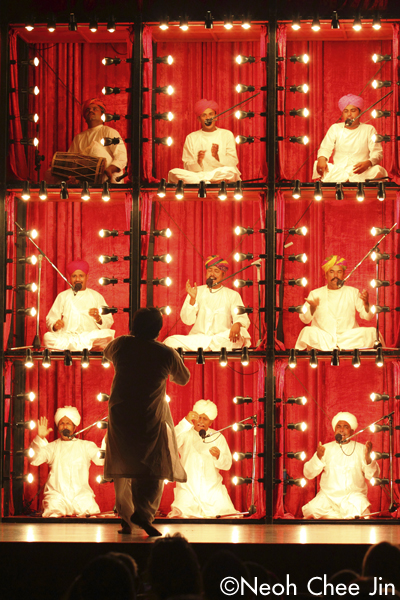
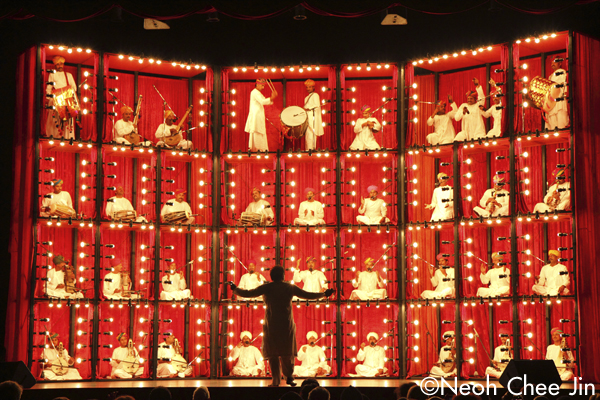
Manganiyar Seduction
George Town Festival 2012
Photo: Neoh Chee Jin

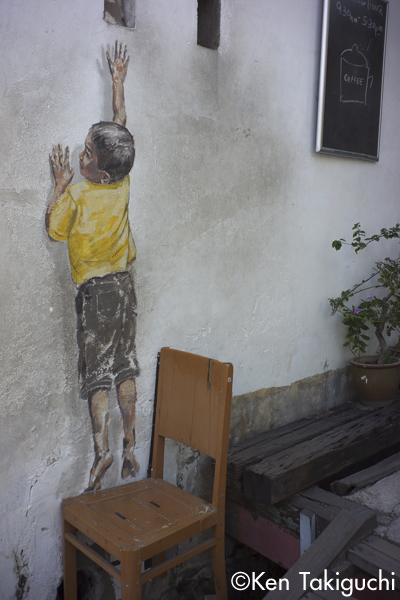
Mirrors George Town
George Town Festival 2012
Photo: Ken Takiguchi
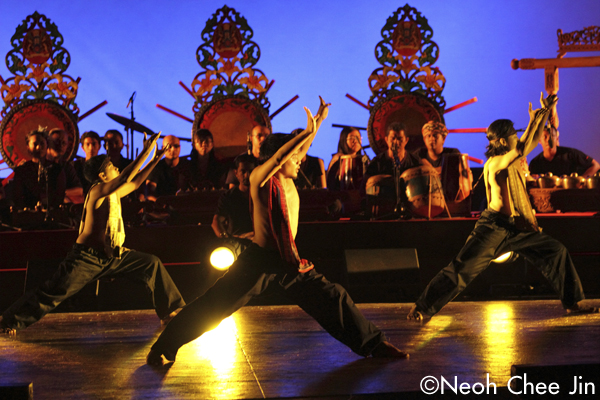
Photo: Neoh Chee Jin
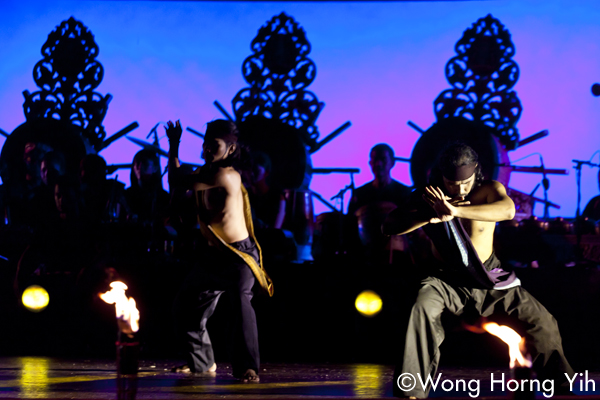
Photo: Wong Horng Yih
Silat – Our Heritage For The World
George Town Festival 2012
Related Tags

